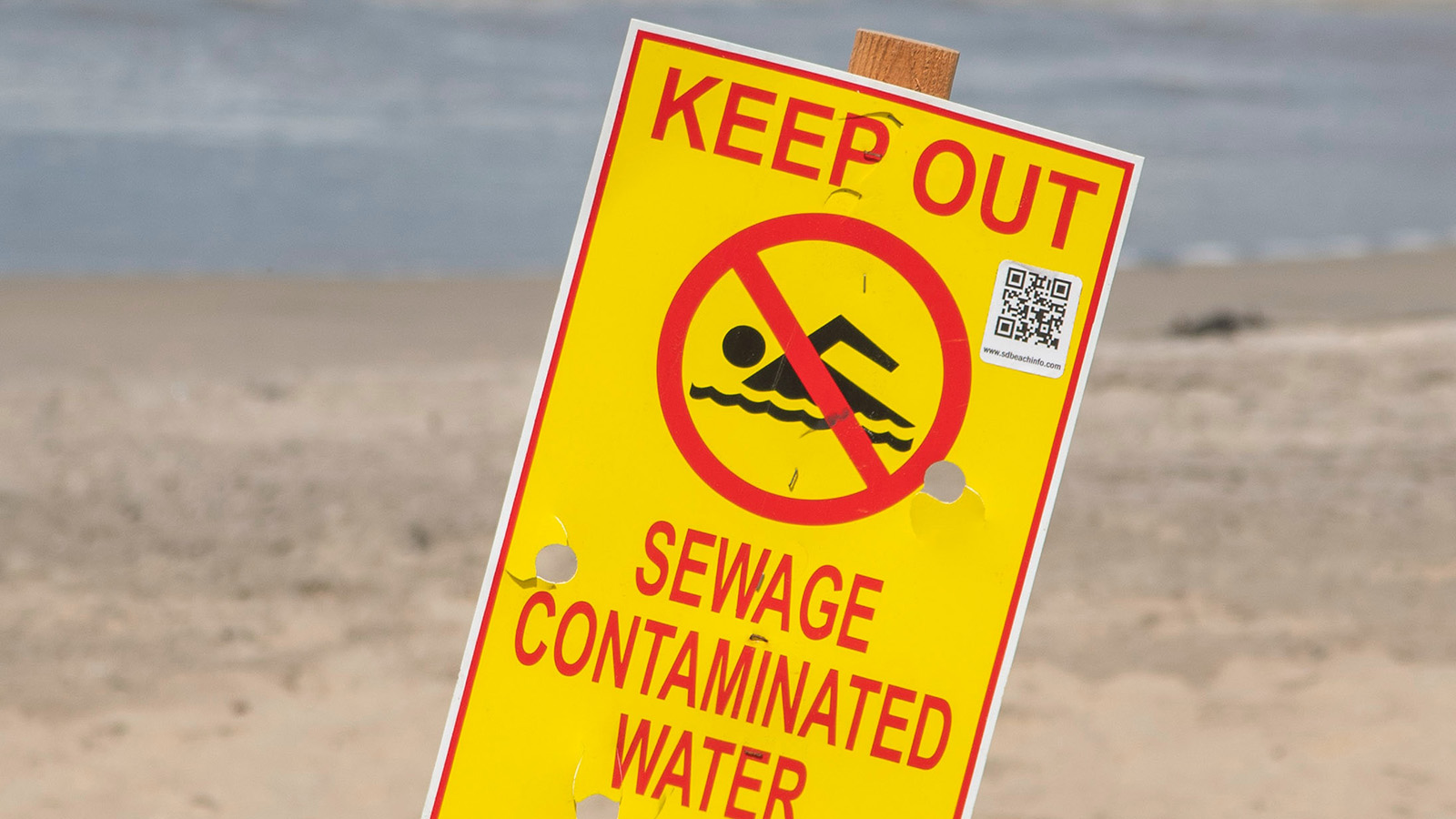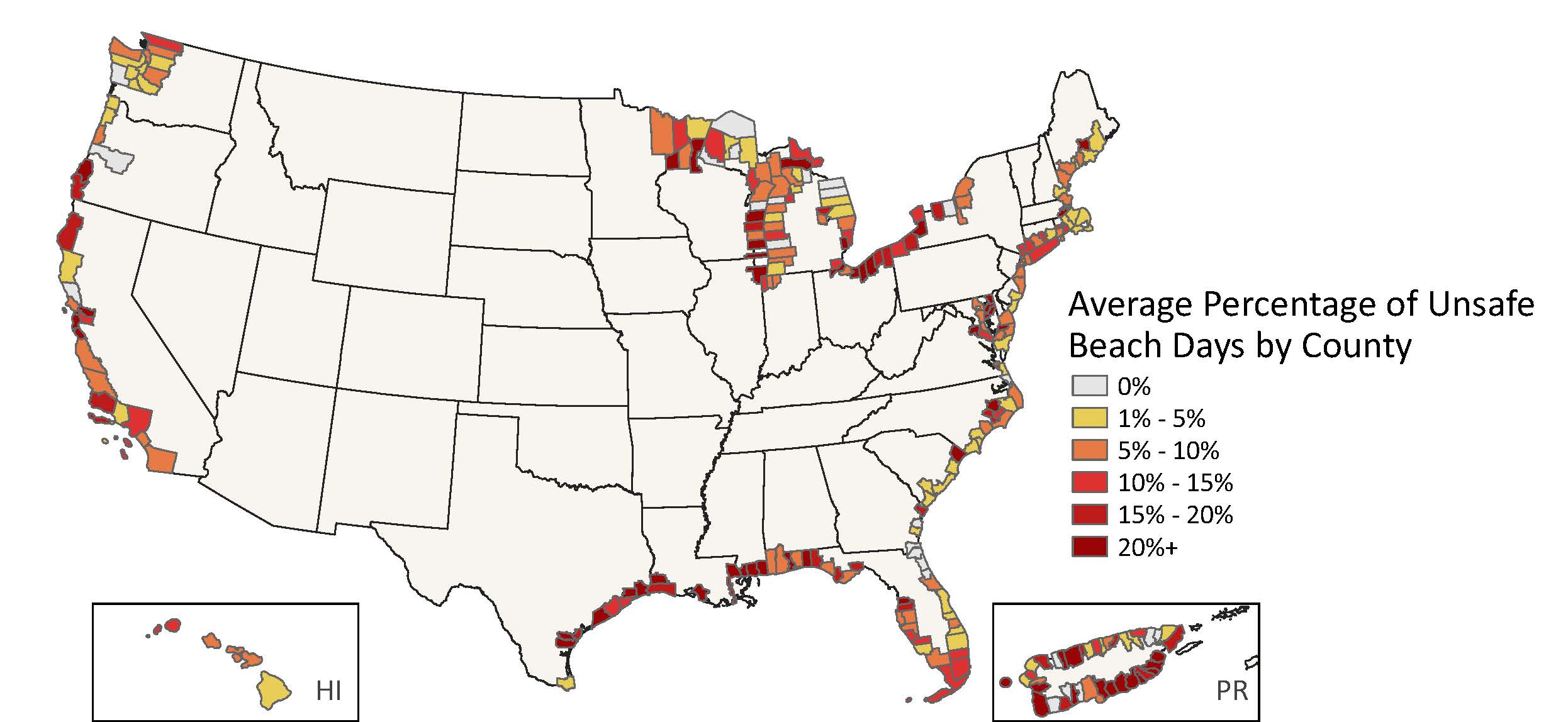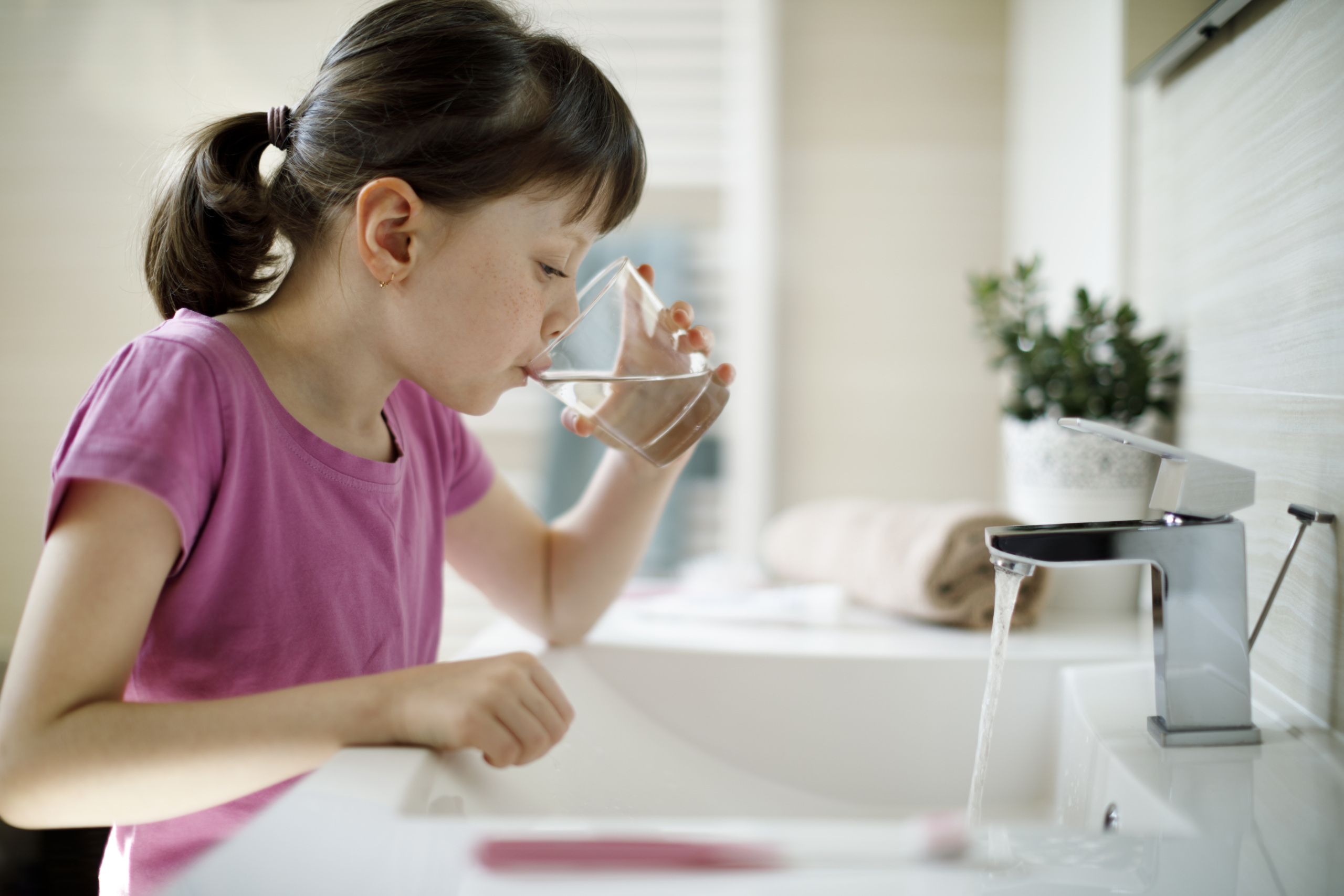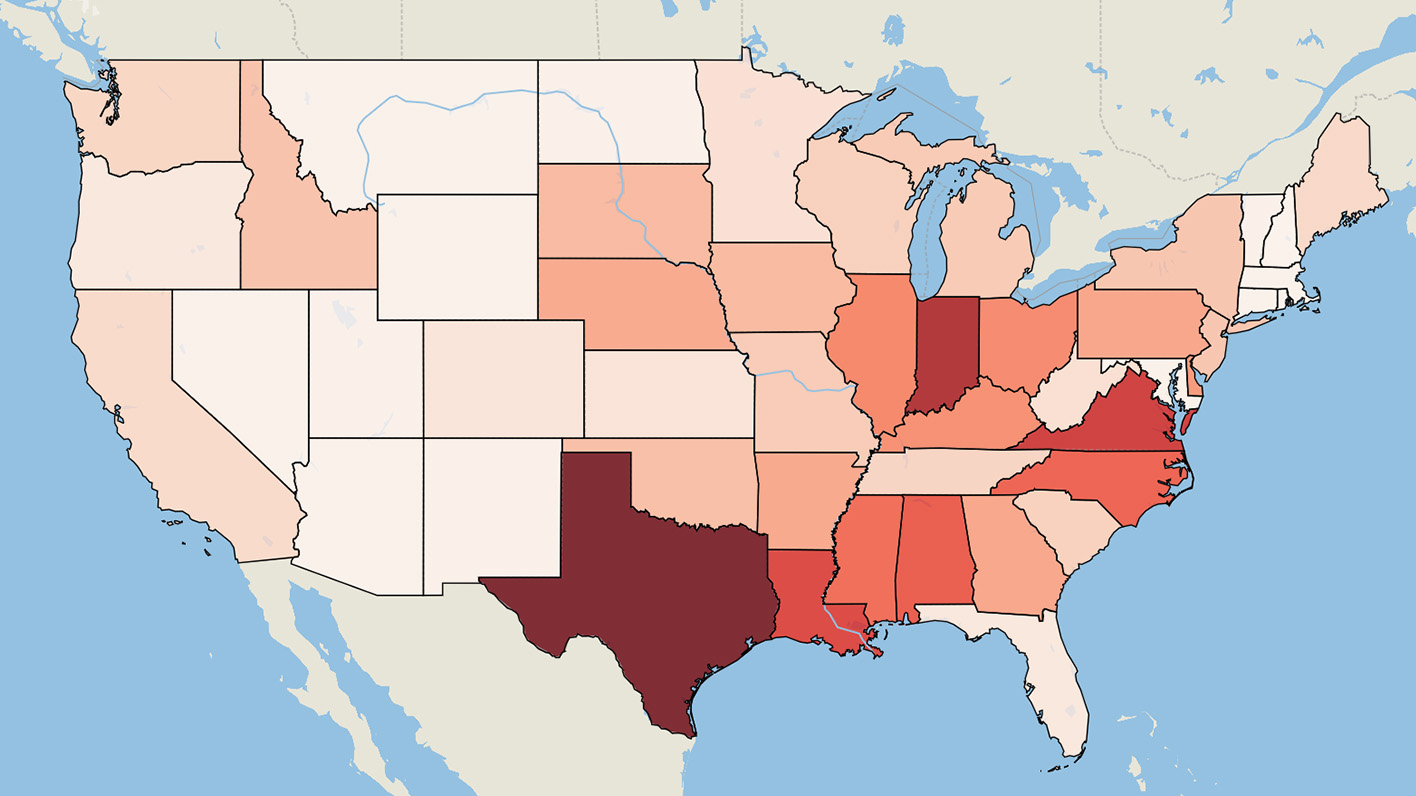
Safe for Swimming?
The Clean Water Act, adopted in 1972 with overwhelming bi-partisan support, had the farsighted and righteous goal of making all our waterways safe for swimming. Yet 46 years later, all too often, Americans visiting their favorite beach are met by an advisory warning that the water is unsafe for swimming.
Downloads
The Clean Water Act, adopted in 1972 with overwhelming bi-partisan support, had the farsighted and righteous goal of making all our waterways safe for swimming. Yet 46 years later, all too often, Americans visiting their favorite beach are met by an advisory warning that the water is unsafe for swimming. Even worse, in recent years millions of Americans have been sickened by swimming in contaminated water.
An analysis of bacteria sampling data from beaches in 29 coastal and Great Lakes states and Puerto Rico reveals that 2,580 beach sites – more than half of all sites tested – were potentially unsafe for swimming on at least one day in 2018, and 546 sites were potentially unsafe at least 25 percent of the days that sampling took place. Sites were considered potentially unsafe if bacteria levels exceeded the U.S. Environmental Protection Agency’s most protective “Beach Action Value” thresholds, which the EPA suggests states use as a “conservative, precautionary tool for making beach notification decisions,” and are associated with an estimated illness rate of 32 per 1,000 swimmers. (Many states use other thresholds for beach closure and advisory decisions. Therefore, results presented in this report may differ from state reports on beach water quality.) (See Methodology for details.)
To keep our beaches safe for swimming and protect Americans’ health, policymakers should undertake efforts to prevent runoff pollution, including through the use of natural and green infrastructure that absorb stormwater onsite.
Fecal contamination makes beaches unsafe for swimming.
- Human contact with the contaminated water indicated by bacteria testing can result in gastrointestinal illness as well as respiratory disease, ear and eye infections and skin rash.
- Each year in the U.S., swimmers suffer from an estimated 57 million cases of recreational waterborne illness.
- Primary sources of fecal contamination include urban runoff, sewage leaks and overflows, and industrial-scale livestock operations.
More than half of the thousands of beach sites sampled for bacteria across the country were potentially unsafe for swimming on at least one day in 2018.
- In 2018, sampling data from 4,523 beach sites in 29 coastal and Great Lakes states and Puerto Rico were submitted to the National Water Quality Monitoring Council.
- Tests at 2,580 sites indicated potentially unsafe levels of fecal contamination for swimming on at least one day, and 546 were potentially unsafe at least 25 percent of the days that sampling took place.
Figure ES-1. Average Percentage of Potentially Unsafe Beach Days in 2018 by County

Bacteria testing of ocean and Great Lakes beaches in every region of the country revealed days of potentially unsafe fecal contamination in 2018.
- Among Gulf Coast beaches, 329 sites, or 85 percent of the 385 sites tested, were unsafe for at least one day in 2018.
- Among West Coast beaches, 571 sites, or 67 percent of the 850 sites tested, were unsafe for at least one day in 2018.
- Among East Coast beaches, 1,134 sites, or 48 percent of the 2,372 sites tested, were unsafe for at least one day in 2018.
- Among Great Lakes beaches, 380 sites, or 68 percent of the 559 sites tested, were unsafe for at least one day in 2018.
In every coastal and Great Lakes state and Puerto Rico, sampling revealed potentially unsafe levels of contamination in 2018.
- Alabama: 21 of 25 beach sites sampled were potentially unsafe for at least one day in 2018. A sampling site at Fairhope Public Beach in Baldwin County was potentially unsafe for 21 days, more than any other site in the state.
- California: 464 of 584 beach sites sampled were potentially unsafe for at least one day in 2018. A sampling site at Inner Cabrillo Beach in Los Angeles County was potentially unsafe for 85 days, more than any other site in the state.
- Connecticut: 81 of 113 beach sites sampled were potentially unsafe for at least one day in 2018. Sampling sites at Byram Beach in Fairfield County were potentially unsafe for 6 days, more than any other site in the state.
- Delaware: 7 of 23 beach sites sampled were potentially unsafe for at least one day in 2018. A sampling site at Slaughter Beach in Sussex County was potentially unsafe for 16 days, more than any other site in the state.
- Florida: 180 of 263 beach sites sampled were potentially unsafe for at least one day in 2018. A sampling site at Bayou Texar in Escambia County was potentially unsafe for 24 days, more than any other site in the state.
- Georgia: 13 of 26 beach sites sampled were potentially unsafe for at least one day in 2018. A sampling site at St. Simons Island Lighthouse in Glynn County was potentially unsafe for 6 days, more than any other site in the state.
- Hawaii: 90 of 218 beach sites sampled were potentially unsafe for at least one day in 2018. The sampling site at Keehi Lagoon (North) in Honolulu County was potentially unsafe for 11 days, more than any other site in the state.
- Illinois: 19 of 19 beach sites sampled were potentially unsafe for at least one day in 2018. A sampling site at South Shore Beach in Cook County was potentially unsafe for 38 days, more than any other site in the state.
- Indiana: 22 of 23 beach sites sampled were potentially unsafe for at least one day in 2018. A sampling site at Jeorse Park Beach in Lake County was potentially unsafe for 38 days, more than any other site in the state.
- Louisiana: 24 of 24 beach sites sampled were potentially unsafe for at least one day in 2018. A sampling site at North Beach in Calcasieu Parish was potentially unsafe for 11 days, more than any other site in the state.
- Maine: 39 of 85 beach sites sampled were potentially unsafe for at least one day in 2018. A sampling site at Goose Rocks Beach in York County was potentially unsafe for 14 days, more than any other site in the state.
- Maryland: 79 of 158 beach sites sampled were potentially unsafe for at least one day in 2018. A sampling site at Camp Pecometh in Kent County was potentially unsafe for 9 days, more than any other site in the state.
- Massachusetts: 223 of 583 beach sites sampled were potentially unsafe for at least one day in 2018. A sampling site at Nahant Bay at Eastern Ave. in Essex County was potentially unsafe for 39 days, more than any other site in the state.
- Michigan: 100 of 207 beach sites sampled were potentially unsafe for at least one day in 2018. A sampling site at St. Clair Shores Memorial Park Beach in Macomb County was potentially unsafe for 18 days, more than any other site in the state.
- Minnesota: 24 of 42 beach sites sampled were potentially unsafe for at least one day in 2018. A sampling site at the New Duluth Boat Club landing facility in St. Louis County was potentially unsafe for 14 days, more than any other site in the state.
- Mississippi: 21 of 21 beach sites sampled were potentially unsafe for at least one day in 2018. A sampling site at Gulfport East Beach in Harrison County was potentially unsafe for 44 days, more than any other site in the state.
- New Hampshire: 15 of 47 beach sites sampled were potentially unsafe for at least one day in 2018. Sampling sites at State Beach in Rockingham County were potentially unsafe for 5 days, more than any other sites in the state.
- New Jersey: 133 of 356 beach sites sampled were potentially unsafe for at least one day in 2018. A sampling site at Beachwood Beach West in Ocean County was potentially unsafe for 14 days, more than any other site in the state.
- New York: 272 of 422 beach sites sampled were potentially unsafe for at least one day in 2018. A sampling site at Tanner Park in Suffolk County was potentially unsafe for 48 days, more than any other site in the state.
- North Carolina: 127 of 213 beach sites sampled were potentially unsafe for at least one day in 2018. A sampling site by the intersection of E. Main St. and Tooley St., in Belhaven, Beaufort County, was potentially unsafe for 11 days, more than any other site in the state.
- Ohio: 55 of 58 beach sites sampled were potentially unsafe for at least one day in 2018. A sampling site at Bay View West in Erie County was potentially unsafe for 42 days, more than any other site in the state.
- Oregon: 18 of 51 beach sites sampled were potentially unsafe for at least one day in 2018. A sampling site at Sunset Bay State Park Beach at the mouth of Big Creek in Coos County was potentially unsafe for 10 days, more than any other site in the state.
- Pennsylvania: 25 of 28 beach sites sampled were potentially unsafe for at least one day in 2018. Sampling sites at Beach 11 in Thompson Bay in Erie County were potentially unsafe for 15 days, more than any other sites in the state.
- Puerto Rico: 76 of 139 beach sites sampled were potentially unsafe for at least one day in 2018. The sampling sites at Playa Guayanes in Yabucoa Municipio and Tropical Beach in Naguabo Municipio were potentially unsafe for 16 days, more than any other site in the state.
- Rhode Island: 54 of 129 beach sites sampled were potentially unsafe for at least one day in 2018. A sampling site at Easton’s Beach in Newport County was potentially unsafe for 10 days, more than any other site in the state.
- South Carolina: 55 of 122 beach sites sampled were potentially unsafe for at least one day in 2018. A sampling site at Withers Swash in Horry County was potentially unsafe for 32 days, more than any other site in the state.
- Texas: 141 of 167 beach sites sampled were potentially unsafe for at least one day in 2018. A sampling site at Cole Park in Nueces County was potentially unsafe for 52 days, more than any other site in the state.
- Virginia: 19 of 37 beach sites sampled were potentially unsafe for at least one day in 2018. A sampling site at North Community Beach in Norfolk City was potentially unsafe for 7 days, more than any other site in the state.
- Washington: 89 of 215 beach sites sampled were potentially unsafe for at least one day in 2018. A sampling site at Sooes Beach in Clallam County was potentially unsafe for 7 days, more than any other site in the state.
- Wisconsin: 94 of 125 beach sites sampled were potentially unsafe for at least one day in 2018. A sampling site at South Shore Beach in Milwaukee County was potentially unsafe for 34 days, more than any other site in the state.
To ensure that all of our beaches are safe for swimming, policymakers should work to protect beaches from runoff and sewage pollution. Solutions include:
- Dramatically increasing funding to fix sewage systems and prevent runoff pollution through natural and green infrastructure, including rain barrels, permeable pavement and green roofs.
- Protecting and restoring natural infrastructure, including riparian areas and wetlands that can filter bacteria, sediment and nutrients.
- Strengthening enforcement of standards for municipal wastewater treatment.
- Enacting moratoria on new or expanded industrial-scale livestock operations, particularly in areas that threaten our beaches and other waterways.
- Using the EPA’s most protective “Beach Action Value” bacteria standard for making beach advisory decisions, and implementing same-day bacteria testing and warning systems.
This report has been revised from the original version.
Topics
Find Out More


The Threat of “Forever Chemicals”

Who are the top toxic water polluters in your state?


